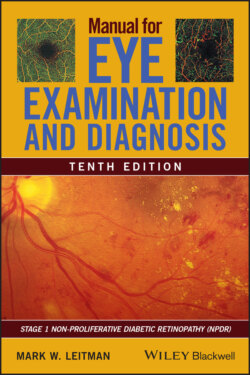Читать книгу Manual for Eye Examination and Diagnosis - Mark W. Leitman - Страница 14
Autoimmune (Graves’) thyroid disease
ОглавлениеThis is a condition in which an orbitopathy may be present with hyper‐ but also hypo‐ or euthyroid disease.
Fig 1 Thyroid exophthalmos with exposed sclera at superior limbus, due to bulging eye.
1 It is the most common cause of bulging eyes, referred to as exophthalmos (proptosis). This is due to fibroblast proliferation and mucopolysaccharide infiltration of the orbit. A small white area of sclera appearing between the lid and upper cornea is diagnostic of thyroid disease 90% of the time (Fig. 1). This exposed sclera may be a result of exophthalmos or thyroid lid retraction due to the stimulation of Müller’s muscle that elevates the lid. Severe orbitopathy may be treated with radiation, surgical decompression of the orbit (Fig. 3), or by administering steroids orally, intravenously, or by injection into the orbit. In January 2020, the FDA approved the human monoclonal antibody, teprotumumab, to treat proptosis, strabismus, and compressive optic neuropathy from thyroid eye disease. It reduced proptosis by more than 2 mm in 71–83% of patients.
1 Infiltration of eye muscles may cause diplopia, which is confirmed by a computed tomography (CT) scan (Figs 2 and 3).
Fig 2 CT scan of thyroid orbitopathy showing fluid infiltration of the medial rectus muscle (M) and normal lateral rectus muscle (L) and proptosis. Compression of left optic nerve could cause optic neuropathy. This is called crowded apex syndrome.
Source: Courtesy of Jack Rootman.
1 Exophthalmos may cause excessive exposure of the eye in the day and an inability to close the lids at night (lagophthalmos), resulting in corneal dessication.Fig 3 Orbital CT scan of Graves’ orbitopathy before surgical decompression (above) and right orbital floor osteotomy (below). Often three, but rarely all four, bony walls may be opened. Note thickened extra ocular muscles.Source: Courtesy of Lelio Baldeschi, MD, and Ophthalmology, July 2007, Vol. 114, pp. 1395–1402.
2 Optic nerve compression is the worst complication and occurs in 4% of patients with thyroid disease. It could cause permanent loss of vision (Fig. 2) and immediate intravenous steroids should be considered when vision is threatened.
